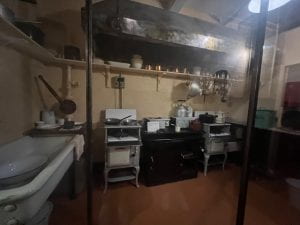By Cecelia Minard

The Jewish experience during World War II was highlighted in nearly every museum we visited, but none of them demonstrated this as poignantly as the Jewish Museum in Berlin. This museum managed to use space to convey the emotional experience of Jewish people in Germany throughout history, making it a truly unforgettable site.
The Imperial War Museum in London had a moving Holocaust exhibit, which included many family photographs, individual stories, and personal belongings. A photograph of a little boy with his friends only months before his death brought me to tears. The Topography of Terror Museum in Berlin did not shy away from the harsh reality of what the Nazis did to the Jewish people, always using the term “murder” rather than “execution.” While the Oscar Schindler Museum in Krakow dissembled the Polish people’s part in the annihilation of the Jews, the museum did show the Jewish experience in an interesting way by recreating the concrete walls of the ghettos and a house of the ghetto.
Despite these museums’ strengths, none compared to the Jewish Museum in Berlin. What made this museum so unique was its ability to capture emotional experiences through physical spaces. Upon entering the permanent exhibit, which consists of three long white intersecting hallways, I immediately felt dizzy but was at first unsure why. I then realized the floors and walls were tilted, and nothing was at a 90-degree angle. The architecture was meant to disorient. The three intersecting hallways were each axes meant to represent an aspect of the Jewish experience. The first was Continuity and Change, showing Jewish history in Germany, the second was Emigration and Exile, which delves into the experience of being forced to leave their homes, and the third was The Holocaust, focusing on the genocide.

The axes of Emigration and Exile lead the visitors to an outdoor exhibit called the Garden of Exile, which consists of a field of 3-meter-tall concrete columns on uneven ground. Walking through these columns evokes a sense of disorientation, meant to represent the instability the displaced Jewish people felt during the Holocaust.
At the end of the axis of The Holocaust is the Holocaust Tower. The tall concrete room is only lit by a small slit in the ceiling, and an eerie ringing noise fades in and out. A feeling of loss and isolation immediately settled over me and my peers and we sat on the floor for about ten minutes, each in silent introspection. This room allowed us to reflect on the devastation of the Holocaust and the cruelty of which humans are capable.





 nce the invasion, making them appear almost natural; the interior walls of the bunker have grown over with lichen and moss, making them an earthy green color.
nce the invasion, making them appear almost natural; the interior walls of the bunker have grown over with lichen and moss, making them an earthy green color.




